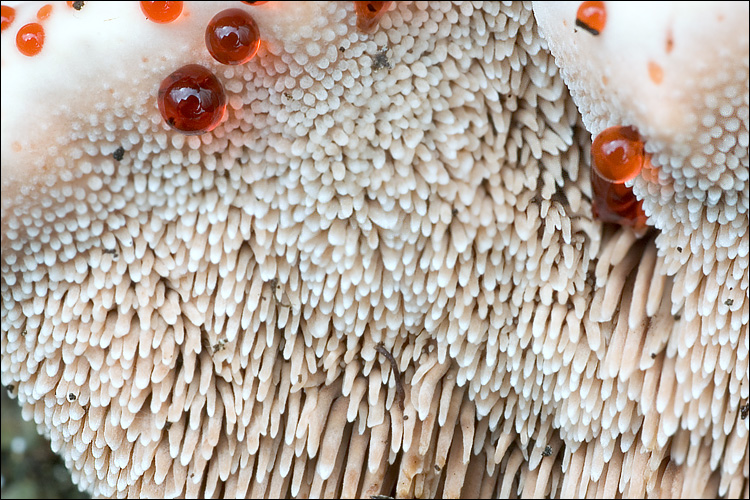|
Phellodon
''Phellodon'' is a genus of tooth fungi in the family Bankeraceae. Species have small- to medium-sized fruitbodies with white spines on the underside from which spores are released. All ''Phellodon'' have a short stalk or stipe, and so the genus falls into the group known as stipitate hydnoid fungi. The tough and leathery flesh usually has a pleasant, fragrant odor, and develops a cork-like texture when dry. Neighboring fruitbodies can fuse, sometimes producing large mats of joined caps. ''Phellodon'' species produce a white spore print, while the individual spores are roughly spherical to ellipsoid in shape, with spiny surfaces. The genus, with about 20 described species, has a distribution that includes to Asia, Europe, North America, South America, Australia, and New Zealand. About half of the species are found in the southeastern United States, including three species added to the genus in 2013–14. Several ''Phellodon'' species were placed on a preliminary Red List ... [...More Info...] [...Related Items...] OR: [Wikipedia] [Google] [Baidu] |
Phellodon Niger
''Phellodon niger'', commonly known as the black tooth, is a species of tooth fungus in the family Bankeraceae, and the type species of the genus ''Phellodon''. It was originally species description, described by Elias Magnus Fries in 1815 as a species of ''Hydnum''. Petter Karsten included it as one of the original three species when he circumscription (taxonomy), circumscribed ''Phellodon'' in 1881. The fungus is found in Europe and North America, although molecular phylogenetics, molecular studies suggest that the North American populations represent a similar but genetically distinct species. Taxonomy ''Phellodon niger'' was originally species description, described by Swedish mycologist Elias Fries in 1815 as a species of ''Hydnum''. The genus ''Phellodon'' was circumscription (taxonomy), circumscribed in 1881 by Finnish mycologist Petter Karsten to contain white-toothed fungi. Karsten included three species: ''Phellodon cyathiformis, P. cyathiformis'', ''Phellodon melal ... [...More Info...] [...Related Items...] OR: [Wikipedia] [Google] [Baidu] |
Phellodon Melaleucus
''Phellodon melaleucus'', commonly known as the grey tooth, is a species of tooth fungus in the family Bankeraceae. It was originally described by Elias Magnus Fries in 1815 as a species of ''Hydnum''. In 1881, Petter Karsten included it as one of the original three species in his newly circumscribed genus '' Phellodon''. The fungus is widely distributed in Europe and North America, where it associates mycorrhizally with a wide range of host trees. It is considered vulnerable in Switzerland. Description The grey tooth is a small to medium-sized fungus with a leathery or corky fruiting body. On the underside it has pale grayish-brown spines from which spores are released rather than from gills. It may look like a convoluted single fruiting body but in fact each part has a blackish stem, and several caps can fuse together. The cap tends to be concentrically zoned with a reddish-brown to blackish-brown centre and a pale edge. The flesh is greyish-brown, darker near the base ... [...More Info...] [...Related Items...] OR: [Wikipedia] [Google] [Baidu] |
Hydnellum
''Hydnellum'' is a genus of tooth fungi in the family Bankeraceae (order Thelephorales). Widely distributed in the Northern Hemisphere, the genus contains around 40 species. The basidiocarp, fruitbodies of its members grow by slowly enveloping nearby bits of grass and vegetation. There is great variability in the form of ''Hydnellum'' fruitbodies, which are greatly influenced by environmental conditions such as rainfall and humidity, drying winds, and temperature. They are too tough and woody to eat comfortably. Several species have become the focus of increasing conservation biology, conservation concern following widespread declines in abundance. ''Hydnellum'' species produce pigments that have been used to dye textiles. Several chemical compounds—some with unique biological activity—have been isolated and identified from the genus. One of the better-known species is the unusual pinkish-white ''Hydnellum peckii'', also known as "strawberries and cream" or as the "bleeding ... [...More Info...] [...Related Items...] OR: [Wikipedia] [Google] [Baidu] |
Tooth Fungi
The hydnoid fungi are a group of fungi in the Basidiomycota with basidiocarps (fruit bodies) producing spores on pendant, tooth-like or spine-like projections. They are colloquially called tooth fungi. Originally such fungi were referred to the genus ''Hydnum'' ("hydnoid" means ''Hydnum''-like), but it is now known that not all hydnoid species are closely related. History ''Hydnum'' was one of the original genera created by Linnaeus in his ''Species Plantarum'' of 1753. It contained all species of fungi with fruit bodies bearing pendant, tooth-like projections. Subsequent authors described around 900 species in the genus. With increasing use of the microscope, it became clear that not all tooth fungi were closely related and most ''Hydnum'' species were gradually moved to other genera. The Dutch mycologist Rudolph Arnold Maas Geesteranus paid particular attention to the group, producing a series of papers reviewing the taxonomy of hydnoid fungi. The original genus ''Hydnum'' is st ... [...More Info...] [...Related Items...] OR: [Wikipedia] [Google] [Baidu] |
Bankeraceae
The ''Bankeraceae'' are a family of fungi in the order Thelephorales. Taxa are terrestrial, and ectomycorrhizal with plant species in families such as Pinaceae or Fagaceae. The family was circumscribed by Marinus Anton Donk in 1961. According to a 2008 estimate, the family contains 6 genera and 98 species. Genera The family consists of the following genera: * '' Bankera'' * '' Boletopsis'' * '' Corneroporus'' * ''Hydnellum'' * '' Neosarcodon * ''Phellodon ''Phellodon'' is a genus of tooth fungi in the family Bankeraceae. Species have small- to medium-sized fruitbodies with white spines on the underside from which spores are released. All ''Phellodon'' have a short stalk or stipe, and so the g ...'' * '' Sarcodon'' References External links * * Thelephorales Basidiomycota families {{Agaricomycetes-stub ... [...More Info...] [...Related Items...] OR: [Wikipedia] [Google] [Baidu] |
Beech
Beech (genus ''Fagus'') is a genus of deciduous trees in the family Fagaceae, native to subtropical (accessory forest element) and temperate (as dominant element of Mesophyte, mesophytic forests) Eurasia and North America. There are 14 accepted species in two distinct subgenera, ''Englerianae'' and ''Fagus''. The subgenus ''Englerianae'' is found only in East Asia, distinctive for its low branches, often made up of several major trunks with yellowish bark. The better known species of subgenus ''Fagus'' are native to Europe, western and eastern Asia and eastern North America. They are high-branching trees with tall, stout trunks and smooth silver-grey bark. The European beech ''Fagus sylvatica'' is the most commonly cultivated species, yielding a utility timber used for furniture construction, flooring and engineering purposes, in plywood, and household items. The timber can be used to build homes. Beechwood makes excellent firewood. Slats of washed beech wood are spread around ... [...More Info...] [...Related Items...] OR: [Wikipedia] [Google] [Baidu] |
Hydnum
''Hydnum'' is a genus of fungi in the family Hydnaceae. They are notable for their unusual spore-bearing structures of teeth rather than Lamella (mycology), gills. The best known are the Edible mushroom, edible species ''Hydnum repandum'' and ''Hydnum rufescens, H. rufescens''. There are no known toxic varieties of ''Hydnum.'' Widely regarded as important maintainers of forest ecosystems, the ''Hydnum'' genus is known to have ectomycorrhizal relationships with multiple plant families. ''Hydnum'' has many brittle, white teeth from which the spores drop. Some species have teeth which hang from ascending branches, while other species have teeth which project downwards from the undersurfaces of dead wood. Most ''Hydnum'' species are safe to eat, and contain many fatty acids and antioxidants. Taxonomy and diversity ''Hydnum'' species are found on every continent that is habitable for plant life, with some preferring deep forest regions. Most of the common species, such as ''H. repandum ... [...More Info...] [...Related Items...] OR: [Wikipedia] [Google] [Baidu] |
Elias Fries
Elias Magnus Fries (15 August 1794 – 8 February 1878) was a Swedish mycologist and botanist. He is sometimes called the "Linnaeus of Mycology". In his works he described and assigned botanical names to hundreds of fungus and lichen species, many of which remain authoritative today. Career Fries was born at Femsjö ( Hylte Municipality), Småland, the son of the pastor there. He attended school in Växjö. He acquired an extensive knowledge of flowering plants from his father. In 1811 Fries entered Lund University where he studied under Carl Adolph Agardh and Anders Jahan Retzius. He obtained his doctorate in 1814. In the same year he was appointed an associate professorship in botany. Fries edited several exsiccata series, the first starting in 1818 under the title ''Lichenes Sveciae exsiccati, curante Elia Fries'' and the last together with Franz Joseph Lagger under the title ''Hieracia europaea exsiccata''. He was elected a member of the Royal Swedish Academy ... [...More Info...] [...Related Items...] OR: [Wikipedia] [Google] [Baidu] |
Botanical Name
A botanical name is a formal scientific name conforming to the ''International Code of Nomenclature for algae, fungi, and plants'' (ICN) and, if it concerns a plant cultigen, the additional cultivar or cultivar group, Group epithets must conform to the ''International Code of Nomenclature for Cultivated Plants'' (ICNCP). The code of nomenclature covers "all organisms traditionally treated as algae, Fungus, fungi, or plants, whether fossil or non-fossil, including blue-green algae (Cyanobacteria), Chytridiomycota, chytrids, oomycetes, slime moulds and Photosynthesis, photosynthetic protists with their taxonomically related non-photosynthetic groups (but excluding Microsporidia)." The purpose of a formal name is to have a single name that is accepted and used worldwide for a particular plant or plant group. For example, the botanical name ''Bellis perennis'' denotes a plant species which is native to most of the countries of Europe and the Middle East, where it has accumulated variou ... [...More Info...] [...Related Items...] OR: [Wikipedia] [Google] [Baidu] |
Petter Adolf Karsten
Petter Adolf Karsten (16 February 1834 – 22 March 1917) was a Finland, Finnish mycology, mycologist, the foremost expert on the fungi of Finland in his day, and known in consequence as the "father of Finnish mycology". Karsten was born in Merimasku near Turku, studied at the University of Helsinki, and then moved to the inland of Tammela, Finland, Tammela, where he spent most of his life with teaching botany and doing research at the Mustiala Agriculture Institute (now the Faculty of Agriculture of the HAMK University of Applied Sciences). He amassed a vast collection, both by his own efforts and those of his correspondents, and named about 200 new genera and 2,000 new species. Between 1861 and 1870 Karsten edited the exsiccata series ''Fungi Fenniae exsiccati. Samling af Finska svampar'' with 1,000 numbers. In his mycological studies he extensively used the microscope and can be considered as the pioneer of fungal microscopy. ''Karstenia'', the international journal of mycology ... [...More Info...] [...Related Items...] OR: [Wikipedia] [Google] [Baidu] |
Genus
Genus (; : genera ) is a taxonomic rank above species and below family (taxonomy), family as used in the biological classification of extant taxon, living and fossil organisms as well as Virus classification#ICTV classification, viruses. In binomial nomenclature, the genus name forms the first part of the binomial species name for each species within the genus. :E.g. ''Panthera leo'' (lion) and ''Panthera onca'' (jaguar) are two species within the genus ''Panthera''. ''Panthera'' is a genus within the family Felidae. The composition of a genus is determined by taxonomy (biology), taxonomists. The standards for genus classification are not strictly codified, so different authorities often produce different classifications for genera. There are some general practices used, however, including the idea that a newly defined genus should fulfill these three criteria to be descriptively useful: # monophyly – all descendants of an ancestral taxon are grouped together (i.e. Phylogeneti ... [...More Info...] [...Related Items...] OR: [Wikipedia] [Google] [Baidu] |







